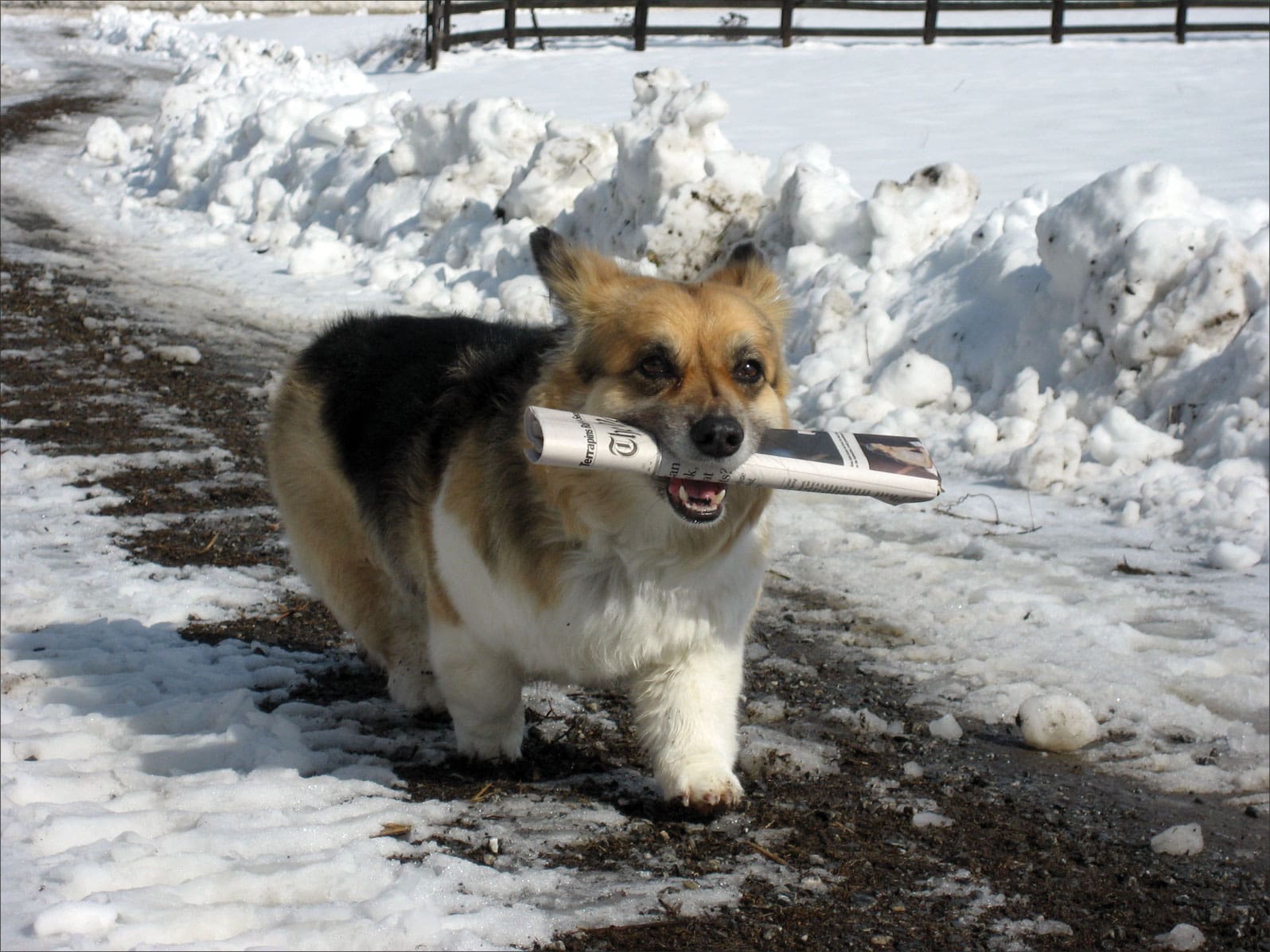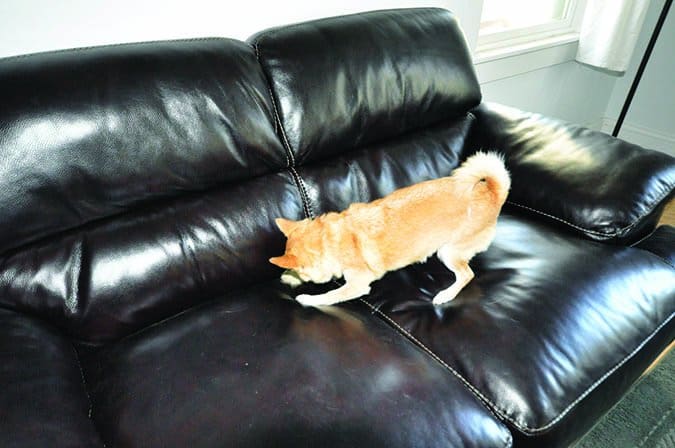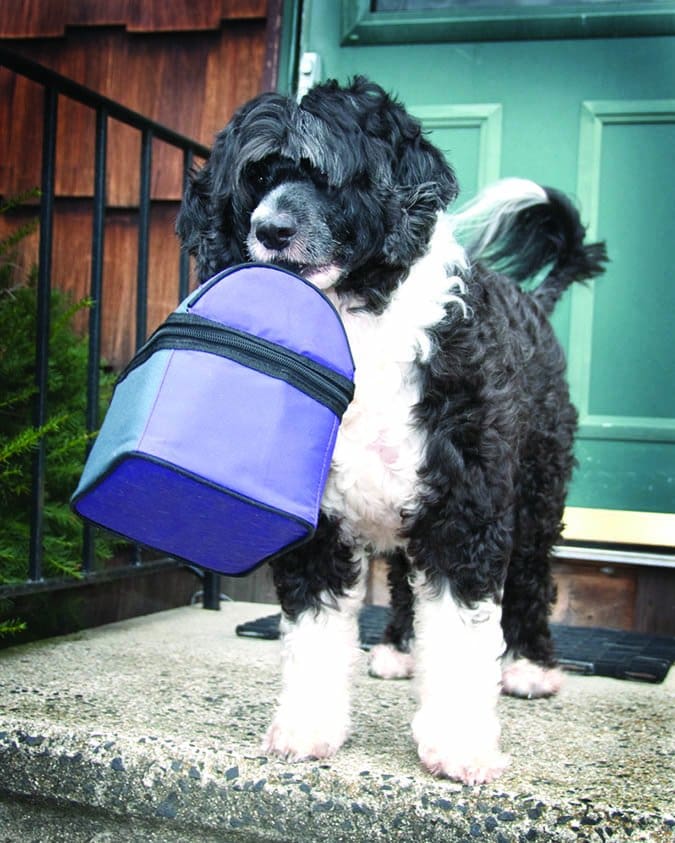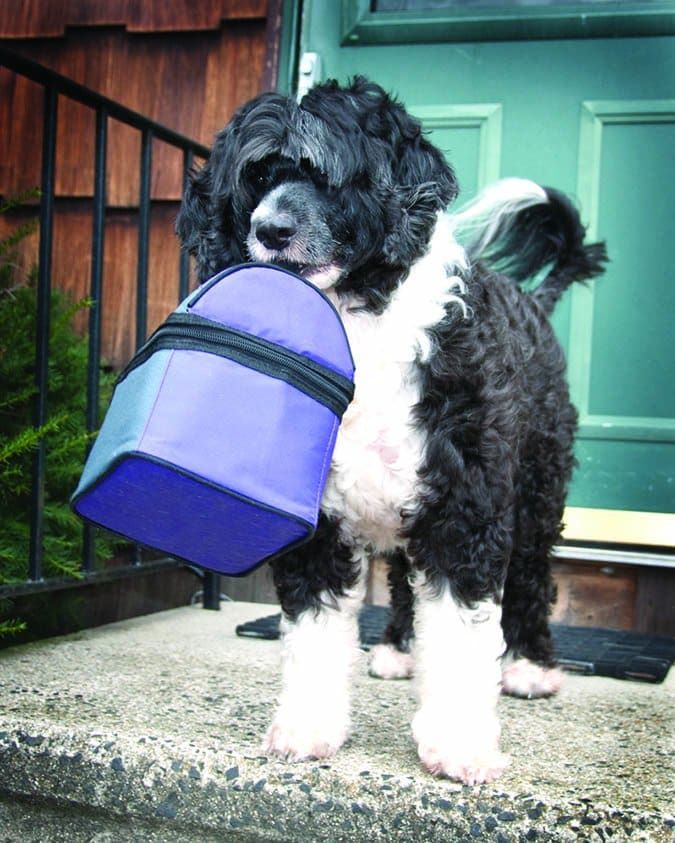Jessie can, among other things, wake up family members; dust with a feather duster; close a left-open toilet lid; mop up spills with a towel; get the mail; use a Dustbuster; mop the floor; polish shoes and boots; take out the trash; pick up dropped items; turn on lights; carry a shopping basket; and push a grocery cart. Some of these behaviors are just for fun; you couldn’t genuinely expect a dog to understand the point of putting polish on your shoes, much less doing a good job of it! But some of them are legitimately helpful!
1. Fetch the Newspaper

Of course there’s the old standby of bringing in the newspaper. Trainer Clarissa Bergeman, CPDT, owner of In Canine Company, in Round Hill, Virginia, enjoyed sharing a walk down the driveway with Anny, her Pembroke Welsh Corgi, to get the newspaper or the mail. Anny was always happy to carry the paper or a magazine on the walk back. Anny is gone now, but Bergeman’s new Corgi, Simon, is learning the task in her stead.
2. Sort Laundry
I thought this one might be particularly up my 8-year-old Scorgidoodle’s (Bonnie) alley, since she loves to hold soft things in her mouth. In fact, I often have to search Bonnie’s crate for socks; if she finds any lying on the floor, she stashes them in her bed.
Since dogs are partially color-blind, it’s probably too much to expect she could sort clothes by color herself, so I started by placing an article of laundry in each of several spots that I named accordingly: Whites, Jeans, Brights (pronounced “Buh-rights,” to help distinguish it from “Whites”), and Towels. The piles were generously far apart at first (six to eight feet between) so I could point to the proper pile without confusing her. I started by handing her a piece of clothing from the basket, gave the cue, pointed to the appropriate pile, and moved with her to the spot. Then I gave her the “Trade” cue, and when she dropped the item on the pile to “trade” for a treat, I clicked my clicker (one could also use a verbal reward marker, such as the word “Yes!”, to indicate that she performed the desired behavior) and gave her a treat.
I quickly faded my movement toward the appropriate pile, finding that the pointing gesture alone sufficed to send her to the proper spot. The “Trade” cue prompted her to drop the item, and a click-treat brought her back to me for the next piece of laundry. We just started this recently, so it’s still a work in progress. Our next step will be to fade the pointing gesture and see if she can identify the proper pile with just a verbal cue.
3. Close Doors
Susan Giordano, CPDT, owner of K9U in Atlanta, Georgia, taught her dog Potter to close the refrigerator, pantry door, and any cabinets that are open. Potter will also fetch a towel so Susan can wipe off the counters. Susan says when they are finished with the chores, they dance!
It’s relatively simple to teach your dog to close doors. Begin by teaching her to target with her nose or paw (hint: using your dog’s nose to close doors rather than a paw reduces the likelihood of scratches to the finish). Offer the palm of your hand to your dog at her nose level. When she sniffs it, click (or say “Yes!”) and treat. Repeat until she eagerly bumps her nose into your hand, and then add the cue “Touch!” as you offer your palm. (If she thinks your offered palm is the cue for “Shake” try the back of your hand, or offer her the knuckles of your closed fist.)
When you are confident she understands the “Touch” cue, hold a plastic lid (such as the top to a tub of cottage cheese or yogurt) in your hand and ask her to touch that. First hold it so it covers your palm, then eventually hold it by the edge.
When she will touch the lid reliably, attach it to a door or drawer with double-stick tape or rubber cement and cue her to touch it there. You may need to start with your hand near the lid and gradually fade the presence of your hand. When she reliably targets her nose to the lid, shape for more powerful touches until she touches hard enough to close the door or drawer. (For tips on using a target stick to teach this behavior, see “Utilize Target Training,” January 2007.)
4. Pick Up Trash
Lots of dogs have been taught to pick up their own toys and put them away in a basket designated for that purpose. Dana Ebbecke, one of the trainers at My Pet’s Teacher in Horsham, Pennsylvania, suggests a variation on that behavior: teaching your dog to pick up trash and put it in a garbage can. This is a perfect behavior to “backchain” – where you teach the last piece of the behavior first, and build the chain backward from there.
Offer your dog a piece of trash (that she won’t want to eat) directly over the center of a garbage can and say “Take it!” When she takes it, praise her, then cue her to “Drop.” If she already knows a “Drop” cue, she will drop the trash and it will fall in the can. Click (or use another reward marker) and treat. If she doesn’t know the “Drop” cue yet, say “Drop” and offer her a treat. When she opens her mouth for the treat the trash will fall in the can. Click and treat.
When the “Drop” is working over the center of the garbage can, move the trash slightly to one side, but still over the can, and cue the “Drop.” If it falls into the can, click and treat. If it misses, say “Oops!” and try it again. Gradually move the “training trash” farther from the center of the can, until it’s no longer even over the can. You are helping the dog understand that she needs to move it back over the middle of the can to make sure it falls inside, not outside the can.
When she can bring the trash that you hand her to the can from some distance, start offering it to her closer to the ground, so she understands she has to lift it up and move it to the can. Finally, place the trash on the ground, and add your “Pick up the trash!” cue before you say “Take it!” In fairly short order you should be able to fade the “Take it!” cue and your “Pick up the trash!” should prompt her to pick up that item and drop it in the can.
Now you’ll need to generalize the cue to a variety of different trash items. Make sure you don’t leave valuable objects on the floor when you ask her to pick up the trash! You can’t expect her to make good judgment calls about what is trash and what is treasure; your smart phone could end up in the garbage.
Ebbecke suggests adding to the “Wow! factor” of this behavior by using a garbage can with a push-pedal lid, and teaching your dog to step on the lid to open the can before she drops the trash in. (Just don’t teach this one to a dog who is likely to help herself to items in the can rather than putting more trash there.)
5. Pick Up/Find/Bring
The “seek back” used to be a behavior performed in advanced obedience competition. You walked around the ring and, when cued by the judge, dropped an item, such as a glove. Your dog was supposed to continuing heeling with you until you stopped and gave him the cue to, go back, get it, and bring it back to you. Very useful!

It’s relatively simple to get your dog to pick up something you just dropped. Your “Pick it up!” cue (from “pick up the trash”) can generalize to anything you indicate you want your dog to pick up – and it sure beats stooping over to get it yourself.
Just think how even more useful it would be if your dog could search for and find, by name, items you’ve misplaced such as your car keys, the TV remote, your cell phone, or your glasses. I realized many years ago how capable dogs are at finding lost stuff when our wonderful Terrier-mix, Josie, found our missing tortoise without even being trained to do so.
I didn’t realize I had taught Josie to associate the word “Turtle” with Fred and Wilma, the two yellow-footed tortoises we had adopted from the shelter where I worked at the time. But apparently I had. One day I couldn’t find Fred. I frantically searched the yard, repeating aloud to myself, “Where’s the turtle?” I eventually realized that Josie was coming to me, and then running to the spot where Fred had fallen behind a retaining wall. Because of that amazing little dog, Fred was found, safe and sound.
Chaser, the brilliant Border Collie and subject of multiple cognition studies, now knows the names of more than 1,000 objects, and can retrieve them by name. Surely your dog can learn the names of a handful of objects, then learn to find them for you when they go missing.
You’ve probably already taught her some, simply by using object names in your conversations with her. “Fetch the ball!” “Go to your bed.” “Get in the car.” So it’s not a stretch to think you can teach her more.
Use your targeting cue, followed by the name of the object. Hold the TV remote in your hand and say “Touch, Remote.” Click (or say “Yes!”) and treat when she does it. Hold your car keys and say “Touch, Keys.” Click and treat. Then place them on a table or floor (one at a time) and do the same. When you’ve done it several times with each item individually, place both on the floor six to eight feet apart, stand six to eight feet away, and ask her to touch one. If she gets the right one, click, treat and party! If she goes to the wrong one, cheerfully say “Oops!” and try again.
If she gets more misses than hits, go back to working with just one object at a time for a while, then try again. Eventually teach her the names of other objects you’d like her to be able to find for you.
When she’s identifying the correct object at least 80 percent of the time, start adding the “Find it!” element. If you’ve already done nose games with your dog, this will be easy as pie. Just as you have been doing already, place one of the objects on the floor in plain view and say “Find Remote!” When she goes over and sniffs it, click and treat. She found it! Repeat several times.
Now start hiding it. First have her sit and wait, and let her watch you hide it in a very easy place. Return to her side and cue, “Find Remote!” When she goes to where it is, click and treat. If you want to teach her a “tell” – a behavior she performs to tell you she found it – start asking her for that behavior when she locates the object. You could have her sit or lie down at the spot where the item was, or she could come back to you and touch you with her paw to let you know she found it, then lead you to it.
Gradually hide objects in harder and harder places, and eventually hide them when she isn’t watching and then ask her to find them. The final step is to have her find things when you’ve really lost them.
You can even take this one step further by teaching her the names of family members and having her find them. Just as you did with objects, have your human hide first in easy places, then harder and harder. If, heaven forbid, a family member is ever truly lost, your dog can join in the search!
6. Reveille
Now that you’ve taught your dog the names of family members, you might as well make every day use of it. Send her to wake up family members who are sleeping in too long. Teach her to pull the covers off the sleepyheads! Have her deliver messages to the kids – carried in her mouth or attached to her collar. Ask her to bring everyone to the table at dinnertime. The sky’s the limit!

Unexpected Help
A dog trainer friend, Deborah Lee Miller-Riley, from Monroe, Connecticut, posted this on her Facebook wall, just as I was writing this article. It’s a great testimonial for the value of teaching your dog a few general purpose helping behaviors. Miller-Riley wrote:
“This morning I attempted to change a small latch on a screen door. I was standing on a 4-foot high front porch, which is bordered by 6-foot high bushes. In my clumsy attempt to screw in the small metal bracket, it flipped out of my hands and landed under the bushes next to the house – a place I would have great difficulty reaching.
“So I called for Rivets, my service-dog-in-training. I showed her a short pathway to the spot where the item fell and told her to ‘Bring,’ her cue to seek and bring something back to my hand. The object would have my fresh scent on it and would most likely stand out to her like a bright color to us. She went right into the bushes, nosed around and pawed at the object. I said, ‘Yes, bring!’ She picked it up, crawled out and delivered it to my hand. She is such a cool dog, her mind and willingness astonishes me. I completed my door repair after a treat fest with my little paw-hero.”






